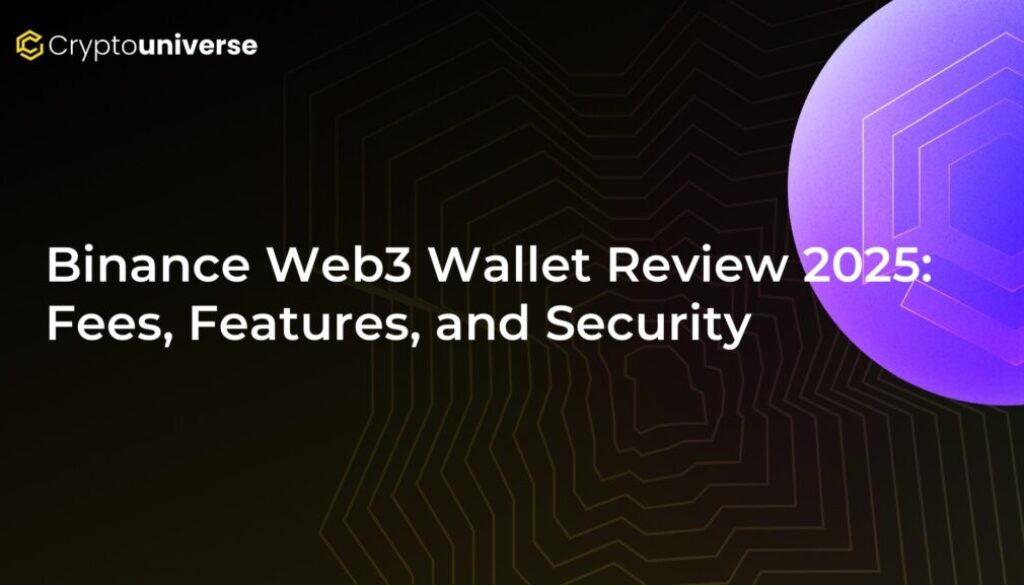Binance Web3 Wallet Review 2025: Fees, Features, and Security

Binance Web3 Wallet Review 2025:
The world of Web3 promises decentralization, true asset ownership, and limitless innovation. Yet, for many, the journey into this new digital frontier is fraught with complexity. Managing long seed phrases, navigating confusing interfaces, and paying unpredictable gas fees can feel like a chore, leaving many users on the sidelines. But what if there was a simpler, more secure way to get started?
Enter the Binance Web3 Wallet, a self-custody crypto wallet built directly into the familiar Binance mobile app. It aims to tear down the barriers to entry, offering a streamlined experience without sacrificing the core principle of self-custody. This review dives deep into its features, security model, and fee structure to help you decide if it’s the right gateway for your Web3 adventures.
What is the Binance Web3 Wallet?
The Binance Web3 Wallet is a non-custodial cryptocurrency wallet that lives inside the main Binance mobile application. The key difference between this and your standard Binance exchange wallet is control. With the exchange wallet, Binance holds your crypto for you (custodial). With the Web3 Wallet, you hold the keys, you control your crypto (self-custody).
It’s designed as a bridge for the millions of Binance users who are curious about Decentralized Finance (DeFi), NFTs, and dApps but are intimidated by the technical hurdles. By leveraging innovative technology, it eliminates one of the biggest pain points for beginners: the dreaded seed phrase.

Key Features That Set It Apart
Binance has packed its Web3 Wallet with features designed for both security and convenience. Let’s break down what makes it tick.
1. Seed Phrase-Free Security with MPC Technology
Perhaps the most significant feature is its use of Multi-Party Computation (MPC). Instead of giving you a 12 or 24-word seed phrase to protect, the wallet splits your private key into three separate “key-shares”:
- Share 1: Stored securely on Binance’s servers.
- Share 2: Stored locally on your mobile device.
- Share 3: Encrypted by your recovery password and backed up to your personal cloud storage (iCloud or Google Drive).
To approve a transaction, you need at least two of these three shares. This design drastically improves security by eliminating a single point of failure. A hacker would need to compromise both your device and your cloud account or your device and Binance’s servers to gain access. Crucially, Binance cannot access your funds on its own, preserving the principles of self-custody.
2. Seamless Multi-Chain Support
The crypto world is a multi-chain universe, and the Binance Web3 Wallet embraces this reality. It supports over 60 blockchains, including major networks like:
- Ethereum (ETH)
- BNB Smart Chain (BNB)
- Solana (SOL)
- Polygon (MATIC)
- Arbitrum (ARB)
- Cosmos (ATOM)
- Bitcoin (BTC)
This allows you to manage a diverse portfolio of tokens and NFTs from a single, unified interface. The wallet also integrates Binance Bridge and other DEX aggregators to help you swap tokens across different chains at optimized prices.
3. Direct Access to dApps and DeFi
The wallet serves as your built-in passport to the decentralized web. You can connect to thousands of dApps for lending, borrowing, staking, and trading without ever leaving the Binance app. Whether you want to trade on PancakeSwap, lend assets on Aave, or browse NFT marketplaces, the wallet facilitates a direct and secure connection.
4. Airdrop Zone and Megadrop Rewards
Binance integrates its reward programs directly into the wallet. The Airdrop Zone and Megadrop platforms allow you to discover and participate in exclusive airdrops from new and emerging Web3 projects. By completing simple tasks or staking BNB, you can earn rewards and get early access to promising tokens.
5. Advanced Security and Risk Alerts
Beyond MPC, the wallet includes built-in safeguards to protect you from common threats. It will alert you if you are about to interact with a known malicious smart contract or send funds to a suspicious address. This proactive risk management adds an essential layer of security, especially for users new to the DeFi space.
Pros and Cons of the Binance Web3 Wallet
No wallet is perfect. Here’s a balanced look at the strengths and weaknesses of Binance’s offering.
| Pros | Cons |
|---|---|
|
|
Understanding the Fee Structure
Binance keeps the fee structure for its Web3 Wallet straightforward. You will primarily encounter two types of fees:
- Network Fees (Gas Fees): These are mandatory fees paid to the blockchain’s validators or miners to process your transaction. Binance does not control or profit from these fees. The cost varies depending on the blockchain (e.g., Ethereum fees are typically higher than BNB Chain fees) and network congestion.
- Swap Fees: When you swap tokens using the wallet’s integrated DEX aggregator, a small fee may apply. However, Binance often runs promotions that waive these swap fees, meaning you only pay the network gas fee.
Depositing and withdrawing funds between your Binance exchange wallet and the Web3 Wallet follows the standard Binance fee schedule.
How to Set Up and Use the Binance Web3 Wallet: A Step-by-Step Guide
Getting started is incredibly simple. Here’s how to create your wallet in minutes.
Step 1: Install the Binance App and Create an Account
First, download the official Binance app from the App Store or Google Play. You’ll need to create a Binance account and complete the identity verification (KYC) process. This is a mandatory step to access the Web3 Wallet feature.
Step 2: Create Your Web3 Wallet
Once your account is verified, open the app, tap on the [Wallets] tab at the bottom right, and then select the [Web3] tab at the top. Tap [Create Wallet] to begin the setup process.
Step 3: Set Your Recovery Password
You will be prompted to create a strong recovery password. This password is critical. It encrypts the third key-share stored in your cloud. Binance cannot see or reset this password, so store it securely and do not forget it.
Step 4: Back Up Your Wallet
The app will ask you to back up your encrypted key-share to either iCloud (for iOS) or Google Drive (for Android). This step is essential for wallet recovery if you lose or change your device. You can also create a QR code backup for an additional layer of safety.
Step 5: Start Exploring Web3
That’s it! Your wallet is ready. You can now transfer crypto from your Binance Spot wallet, receive funds from other wallets, swap tokens, and explore dApps through the [Discover] tab.
Frequently Asked Questions (FAQ)
Is the Binance Web3 Wallet safe and legit?
Yes, it is considered safe and legitimate. It is developed and integrated by Binance, one of the world’s largest crypto exchanges. Its security is anchored by MPC technology, which is arguably more secure against common user errors than traditional seed phrases. Additionally, it includes risk alerts for malicious contracts and addresses.
What’s the difference between the Web3 Wallet and the Binance Exchange Wallet?
The main difference is custody. The Exchange Wallet is custodial, meaning Binance holds your private keys and secures your assets. The Web3 Wallet is self-custodial, meaning you control your private keys (via the MPC system) and have full ownership of your assets.
Is the Binance Web3 Wallet available in the USA?
No, the Binance Web3 Wallet is not available to users in the United States. U.S. customers are directed to Binance.US, a separate platform that complies with U.S. regulations and does not currently offer the integrated Web3 Wallet feature.
Which countries can use the Binance Web3 Wallet?
The wallet is available in most of the 100+ countries where the global Binance.com platform operates. This includes large parts of Europe, Asia, Latin America, and the Middle East. It is restricted in countries like the United States, Canada, Iran, North Korea, and Syria due to regulatory and compliance reasons.
Conclusion: Is the Binance Web3 Wallet Right for You?
The Binance Web3 Wallet is a powerful and well-designed tool that successfully lowers the barrier to entry for Web3. Its brilliant use of MPC technology to eliminate seed phrases makes it one of the most user-friendly and secure options for beginners.
If you are an existing Binance user or someone looking for a simple, all-in-one solution to start exploring DeFi and NFTs without the usual technical headaches, this wallet is an outstanding choice.
However, if you are a decentralization purist who prefers a browser extension, a desktop interface, or wants to avoid any link to a centralized exchange, you might prefer alternatives like MetaMask or a dedicated hardware wallet. Ultimately, the Binance Web3 Wallet Review 2025 shows a product that masterfully balances security, convenience, and power, making it a compelling gateway to the decentralized future.


